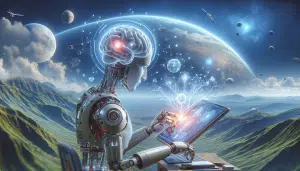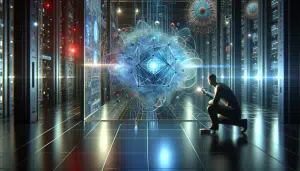Surprising Ways Artificial Intelligence Impacts Daily Life
Ethan Harris October 23, 2025
Artificial intelligence shapes daily experiences in subtle and profound ways. Discover how advanced machine learning, natural language processing, and automation influence daily activities, streamline routines, and even help make smarter decisions. Explore the practical side of AI and its surprising impact on ordinary routines.
AI at Work and in the Office
Artificial intelligence has transformed offices and workspaces worldwide. Smart automation allows businesses to manage day-to-day tasks more efficiently, enhancing both productivity and employee satisfaction. Many organizations now use AI-driven tools for scheduling meetings, analyzing large data sets, and helping with document management. Chatbots handle customer queries without human intervention, increasing efficiency while enabling employees to focus on critical thinking roles. These shifts aren’t always flashy, but their impact is noticeable. Automation in administrative tasks and predictive analytics is now an essential part of many companies’ business process management strategies, adding value without being overly visible to end users.
Another crucial area where artificial intelligence makes a difference is in data privacy and security. Companies deploy advanced algorithms to detect suspicious activities and potential security breaches in real-time, helping reduce the risk of cyber threats. AI systems learn to recognize normal patterns and flag unusual ones, aiding IT professionals who work behind the scenes. Machine learning models now play a significant role in risk management, protecting both organizations and their clients. With sensitive information becoming increasingly digital, the importance of robust cybersecurity supported by AI cannot be overstated.
Remote work technologies harness artificial intelligence to support remote teams. Virtual meeting assistants listen, transcribe, and even summarize action points, making remote collaboration more organized. AI-driven optimization of schedules and workflows helps balance workloads and identify productivity gaps, helping teams perform at their best. By integrating smart tech, businesses adapt to the evolving demands of flexible work environments while ensuring employees receive real-time support. The combination of digital adoption and artificial intelligence allows companies to remain agile and competitive in dynamic markets.
Smart Homes and Daily Routines
Modern homes are quietly powered by artificial intelligence. Virtual assistants like Alexa or Google Assistant respond to voice commands, manage reminders, set alarms, and control connected devices. These AI-driven systems use machine learning to learn user preferences, helping homeowners adjust lighting, temperature, and entertainment. The power of connected smart devices lies in their seamless operation, offering convenience that feels almost magical. The rise of the Internet of Things, coupled with artificial intelligence, has made living spaces more adaptable to changing needs and lifestyles.
AI also brings significant advancements in energy efficiency. Smart thermostats analyze patterns and weather forecasts to optimize heating and cooling systems, leading to savings and reduced energy footprints. Appliances now use sensors to detect load sizes, adjusting cycles for better water and power use. Regular routine management—like scheduling chores or maintaining grocery lists—is smoother thanks to predictive algorithms in mobile apps. These features collectively save time and resources, helping residents lead more comfortable and sustainable lives without extra effort.
Home security benefits substantially from artificial intelligence. Surveillance systems deploy AI algorithms to distinguish between regular activities and anomalies, such as unexpected motion at unusual times. This enables quick alerts when something is amiss and can even automate responses like locking doors or contacting authorities. With AI-trained facial recognition and object detection, smart home devices can better protect families and property. As these capabilities mature, they deliver peace of mind and foster more responsive living environments for households of all sizes.
Entertainment and Personalized Experiences
Artificial intelligence defines the digital entertainment experience. Streaming platforms such as Netflix and Spotify use recommendation engines fueled by machine learning to curate personalized suggestions. By analyzing viewing or listening histories, AI identifies patterns and suggests similar content, creating a custom entertainment journey. This predictive personalization keeps audiences engaged, introducing them to new genres, artists, or series based on their preferences—even before they’re aware of their own evolving tastes.
Video games increasingly leverage AI to provide more immersive and dynamic experiences. Non-player characters demonstrate intelligence that feels life-like, adapting to player behavior in real-time. Procedural content generation, supported by artificial intelligence, leads to unique storylines and ever-changing challenges that surprise even seasoned gamers. AI’s presence in entertainment design extends to animation, virtual reality, and live performances, where interactive environments respond to audience inputs for richer, more engaging sessions.
Social media platforms integrate artificial intelligence to curate newsfeeds, flag inappropriate content, and optimize interactions. Algorithms sort posts based on relevance, popularity, and user engagement, shaping the information people see daily. Trend analysis identifies popular discussions, surfacing them for wider audiences. Facial recognition and image tagging features make photo organization faster and more intuitive. These technological advancements, while sometimes controversial, are central to the evolving nature of digital social interactions.
Transportation and Smart Mobility Solutions
Artificial intelligence revolutionizes how people move. Navigation applications like Google Maps or Waze rely on machine learning to predict traffic, suggest alternate routes, or update estimated arrival times. By processing real-time data from millions of sources, AI helps drivers avoid delays while optimizing travel time. For public transportation, predictive models assist in scheduling, anticipate maintenance needs, and enhance safety by tracking unusual patterns in system operations. These solutions create smoother journeys for commuters and travelers alike.
Self-driving technology has become one of the most visible demonstrations of artificial intelligence in daily life. Autonomous vehicles use massive sensor arrays, machine learning, and real-time analytics to navigate traffic, recognize hazards, and make split-second decisions. While full autonomy remains under development, many cars on the road use AI-powered assistance for lane-keeping, adaptive cruise control, parking, and emergency braking. These features not only improve safety but also reduce the stress of driving in busy environments.
Mobility-as-a-service platforms, like ridesharing and micromobility, depend on artificial intelligence for fleet management, pricing, and demand forecasting. Predictive analytics help balance supply with demand, ensuring bikes, scooters, or cars are available where needed. AI also supports contactless payment and personalized route recommendations. These advancements contribute to more sustainable, flexible, and user-centered transportation systems that adapt to changing urban landscapes and commuter expectations.
Healthcare Innovations Powered by AI
Healthcare is experiencing a digital transformation supported by artificial intelligence. Diagnostic systems now process medical images, interpret lab results, and deliver preliminary assessments with impressive accuracy. Machine learning models aid radiologists in detecting conditions such as tumors or fractures, sometimes catching subtle variations unnoticeable to the human eye. Patients benefit from earlier detection and more reliable second opinions, which can make a significant difference in treatment outcomes.
AI-driven clinical decision support tools help doctors tailor treatments. Algorithms consider massive amounts of data, from medical histories to genetic profiles, to recommend customized care plans. These technologies do not replace physicians but provide actionable insights based on evidence and trends, assisting with diagnoses and helping manage complex chronic conditions. Natural language processing further streamlines record-keeping and patient communication, easing administrative burdens for healthcare providers.
Wearables and remote monitoring devices use AI to turn health data into personalized advice. From tracking vital signs to detecting arrhythmias, these tools alert users and care teams to critical changes. Advances in digital health management empower individuals to maintain wellness through daily insights, medication reminders, and behavioral nudges. As artificial intelligence integrates further into health systems and personal devices, the landscape of preventive and precision medicine continues to evolve for the better.
Education and Learning in the Age of AI
Artificial intelligence opens new avenues in education, making learning more adaptive and accessible. Smart tutoring systems tailor instructional content and feedback to the needs of each learner, identifying knowledge gaps and adjusting to individual paces. Personalized lesson plans, supported by AI analytics, boost engagement and motivation among students of all ages. Schools and universities benefit from tech-enabled early intervention, helping instructors identify potential challenges before they hinder academic progress.
Language processing algorithms drive new opportunities for inclusive education. Automated translation and speech-to-text features support diverse learners, breaking down language barriers and supporting those with disabilities. AI toolkits simplify administrative routines such as grading or enrollment, freeing educators to focus on teaching quality and mentorship. Edtech platforms now offer interactive simulations, virtual classrooms, and real-time feedback, enhancing the educational experience beyond traditional textbooks and lectures.
Lifelong learning and professional development are also benefiting from artificial intelligence. Online learning platforms use AI to recommend relevant courses and connect learners with mentors, peer groups, or tailored resources. This technology-driven approach has helped democratize education, creating new pathways for skills development regardless of age or background. As the pace of change accelerates, having accessible digital learning resources ensures that more people can adapt to emerging opportunities in the modern workforce.
References
1. Kaur, P., & Chana, I. (2022). Artificial intelligence in daily life: Applications and future perspectives. Retrieved from https://www.ncbi.nlm.nih.gov/pmc/articles/PMC8825454/
2. U.S. Department of Energy. (n.d.). Artificial Intelligence and Machine Learning Research. Retrieved from https://www.energy.gov/science-innovation/office-science/artificial-intelligence
3. Brookings Institution. (n.d.). How artificial intelligence is transforming the world. Retrieved from https://www.brookings.edu/articles/how-artificial-intelligence-is-transforming-the-world/
4. World Health Organization. (n.d.). Ethics and governance of artificial intelligence for health. Retrieved from https://www.who.int/publications/i/item/9789240029200
5. Pew Research Center. (2021). Experts say the ‘new normal’ in 2025 will be far more tech-driven, presenting more big challenges. Retrieved from https://www.pewresearch.org/internet/2021/02/18/experts-say-the-new-normal-in-2025-will-be-far-more-tech-driven-presenting-more-big-challenges/
6. MIT Sloan Management Review. (2019). Artificial Intelligence in Business Gets Real. Retrieved from https://sloanreview.mit.edu/projects/artificial-intelligence-in-business-gets-real/







